fuel FIAT TALENTO 2020 Owner handbook (in English)
[x] Cancel search | Manufacturer: FIAT, Model Year: 2020, Model line: TALENTO, Model: FIAT TALENTO 2020Pages: 236, PDF Size: 4.86 MB
Page 4 of 236
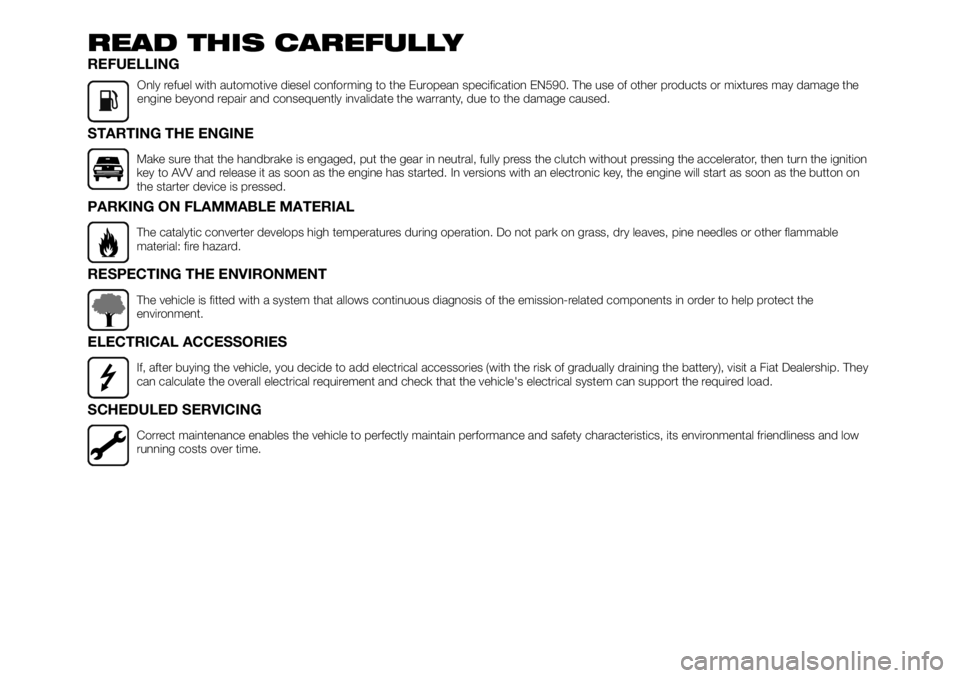
READ THIS CAREFULLY
REFUELLING
Only refuel with automotive diesel conforming to the European specification EN590. The use of other products or mixtures may damage the
engine beyond repair and consequently invalidate the warranty, due to the damage caused.
STARTING THE ENGINE
Make sure that the handbrake is engaged, put the gear in neutral, fully press the clutch without pressing the accelerator, then turn the ignition
key to AVV and release it as soon as the engine has started. In versions with an electronic key, the engine will start as soon as the button on
the starter device is pressed.
PARKING ON FLAMMABLE MATERIAL
The catalytic converter develops high temperatures during operation. Do not park on grass, dry leaves, pine needles or other flammable
material: fire hazard.
RESPECTING THE ENVIRONMENT
The vehicle is fitted with a system that allows continuous diagnosis of the emission-related components in order to help protect the
environment.
ELECTRICAL ACCESSORIES
If, after buying the vehicle, you decide to add electrical accessories (with the risk of gradually draining the battery), visit a Fiat Dealership. They
can calculate the overall electrical requirement and check that the vehicle's electrical system can support the required load.
SCHEDULED SERVICING
Correct maintenance enables the vehicle to perfectly maintain performance and safety characteristics, its environmental friendliness and low
running costs over time.
Page 14 of 236
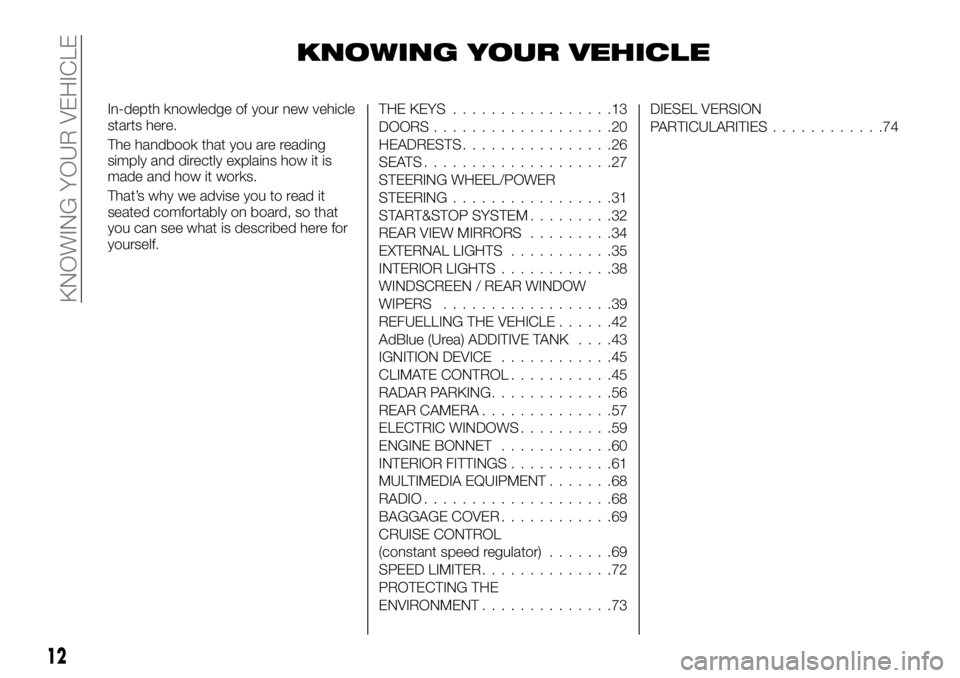
KNOWING YOUR VEHICLE
In-depth knowledge of your new vehicle
starts here.
The handbook that you are reading
simply and directly explains how it is
made and how it works.
That’s why we advise you to read it
seated comfortably on board, so that
you can see what is described here for
yourself.THE KEYS.................13
DOORS...................20
HEADRESTS................26
SEATS....................27
STEERING WHEEL/POWER
STEERING.................31
START&STOP SYSTEM.........32
REAR VIEW MIRRORS.........34
EXTERNAL LIGHTS...........35
INTERIOR LIGHTS............38
WINDSCREEN / REAR WINDOW
WIPERS..................39
REFUELLING THE VEHICLE......42
AdBlue (Urea) ADDITIVE TANK....43
IGNITION DEVICE............45
CLIMATE CONTROL...........45
RADAR PARKING.............56
REAR CAMERA..............57
ELECTRIC WINDOWS..........59
ENGINE BONNET............60
INTERIOR FITTINGS...........61
MULTIMEDIA EQUIPMENT.......68
RADIO....................68
BAGGAGE COVER............69
CRUISE CONTROL
(constant speed regulator).......69
SPEED LIMITER..............72
PROTECTING THE
ENVIRONMENT..............73DIESEL VERSION
PARTICULARITIES............74
12
KNOWING YOUR VEHICLE
Page 28 of 236
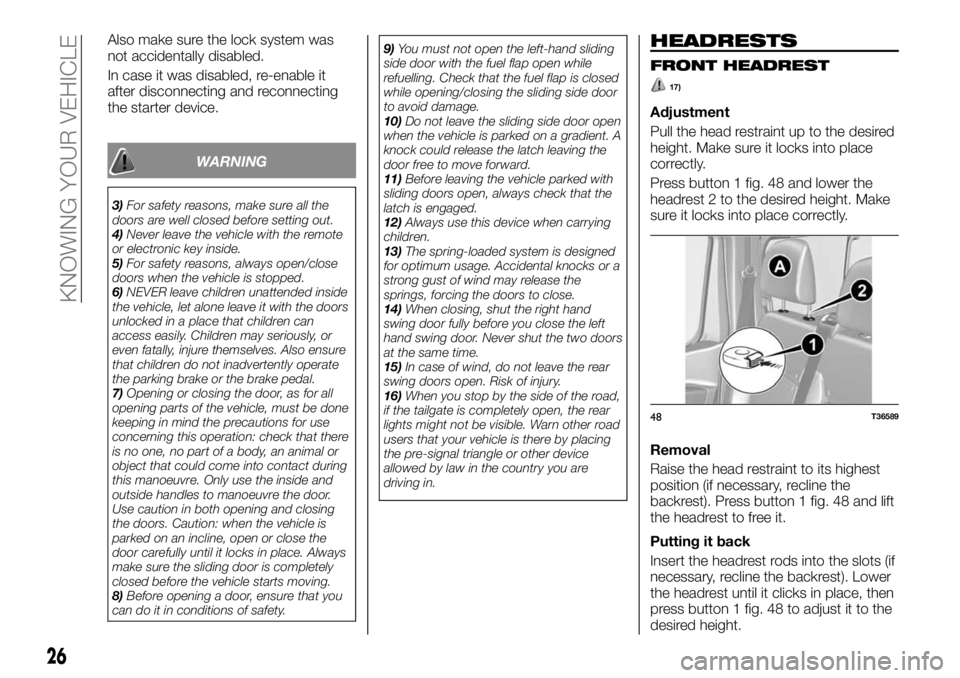
Also make sure the lock system was
not accidentally disabled.
In case it was disabled, re-enable it
after disconnecting and reconnecting
the starter device.
WARNING
3)For safety reasons, make sure all the
doors are well closed before setting out.
4)Never leave the vehicle with the remote
or electronic key inside.
5)For safety reasons, always open/close
doors when the vehicle is stopped.
6)NEVER leave children unattended inside
the vehicle, let alone leave it with the doors
unlocked in a place that children can
access easily. Children may seriously, or
even fatally, injure themselves. Also ensure
that children do not inadvertently operate
the parking brake or the brake pedal.
7)Opening or closing the door, as for all
opening parts of the vehicle, must be done
keeping in mind the precautions for use
concerning this operation: check that there
is no one, no part of a body, an animal or
object that could come into contact during
this manoeuvre. Only use the inside and
outside handles to manoeuvre the door.
Use caution in both opening and closing
the doors. Caution: when the vehicle is
parked on an incline, open or close the
door carefully until it locks in place. Always
make sure the sliding door is completely
closed before the vehicle starts moving.
8)Before opening a door, ensure that you
can do it in conditions of safety.9)You must not open the left-hand sliding
side door with the fuel flap open while
refuelling. Check that the fuel flap is closed
while opening/closing the sliding side door
to avoid damage.
10)Do not leave the sliding side door open
when the vehicle is parked on a gradient. A
knock could release the latch leaving the
door free to move forward.
11)Before leaving the vehicle parked with
sliding doors open, always check that the
latch is engaged.
12)Always use this device when carrying
children.
13)The spring-loaded system is designed
for optimum usage. Accidental knocks or a
strong gust of wind may release the
springs, forcing the doors to close.
14)When closing, shut the right hand
swing door fully before you close the left
hand swing door. Never shut the two doors
at the same time.
15)In case of wind, do not leave the rear
swing doors open. Risk of injury.
16)When you stop by the side of the road,
if the tailgate is completely open, the rear
lights might not be visible. Warn other road
users that your vehicle is there by placing
the pre-signal triangle or other device
allowed by law in the country you are
driving in.
HEADRESTS
FRONT HEADREST
17)
Adjustment
Pull the head restraint up to the desired
height. Make sure it locks into place
correctly.
Press button 1 fig. 48 and lower the
headrest 2 to the desired height. Make
sure it locks into place correctly.
Removal
Raise the head restraint to its highest
position (if necessary, recline the
backrest). Press button 1 fig. 48 and lift
the headrest to free it.
Putting it back
Insert the headrest rods into the slots (if
necessary, recline the backrest). Lower
the headrest until it clicks in place, then
press button 1 fig. 48 to adjust it to the
desired height.
48T36589
26
KNOWING YOUR VEHICLE
Page 34 of 236
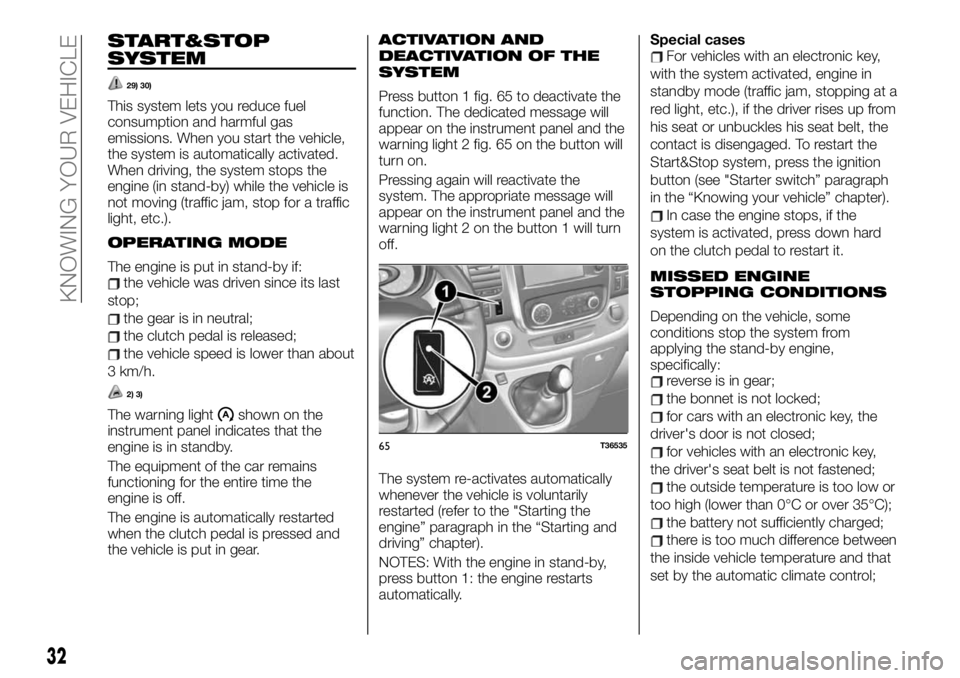
START&STOP
SYSTEM
29) 30)
This system lets you reduce fuel
consumption and harmful gas
emissions. When you start the vehicle,
the system is automatically activated.
When driving, the system stops the
engine (in stand-by) while the vehicle is
not moving (traffic jam, stop for a traffic
light, etc.).
OPERATING MODE
The engine is put in stand-by if:the vehicle was driven since its last
stop;
the gear is in neutral;
the clutch pedal is released;
the vehicle speed is lower than about
3 km/h.
2) 3)
The warning lightshown on the
instrument panel indicates that the
engine is in standby.
The equipment of the car remains
functioning for the entire time the
engine is off.
The engine is automatically restarted
when the clutch pedal is pressed and
the vehicle is put in gear.
ACTIVATION AND
DEACTIVATION OF THE
SYSTEM
Press button 1 fig. 65 to deactivate the
function. The dedicated message will
appear on the instrument panel and the
warning light 2 fig. 65 on the button will
turn on.
Pressing again will reactivate the
system. The appropriate message will
appear on the instrument panel and the
warning light 2 on the button 1 will turn
off.
The system re-activates automatically
whenever the vehicle is voluntarily
restarted (refer to the "Starting the
engine” paragraph in the “Starting and
driving” chapter).
NOTES: With the engine in stand-by,
press button 1: the engine restarts
automatically.Special cases
For vehicles with an electronic key,
with the system activated, engine in
standby mode (traffic jam, stopping at a
red light, etc.), if the driver rises up from
his seat or unbuckles his seat belt, the
contact is disengaged. To restart the
Start&Stop system, press the ignition
button (see "Starter switch” paragraph
in the “Knowing your vehicle” chapter).
In case the engine stops, if the
system is activated, press down hard
on the clutch pedal to restart it.
MISSED ENGINE
STOPPING CONDITIONS
Depending on the vehicle, some
conditions stop the system from
applying the stand-by engine,
specifically:
reverse is in gear;
the bonnet is not locked;
for cars with an electronic key, the
driver's door is not closed;
for vehicles with an electronic key,
the driver's seat belt is not fastened;
the outside temperature is too low or
too high (lower than 0°C or over 35°C);
the battery not sufficiently charged;
there is too much difference between
the inside vehicle temperature and that
set by the automatic climate control;
65T36535
32
KNOWING YOUR VEHICLE
Page 35 of 236
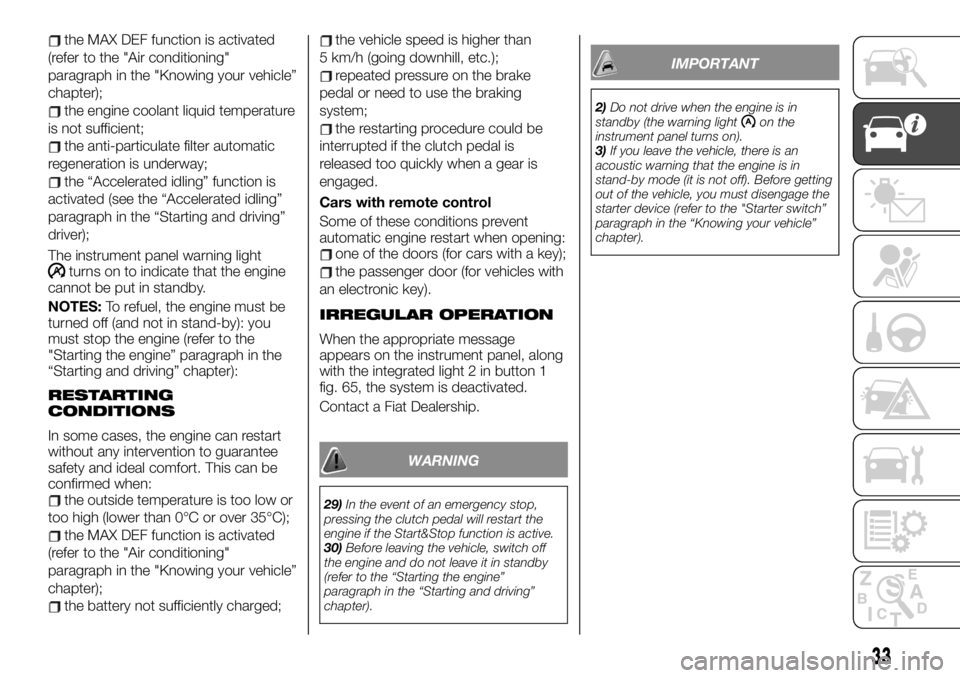
the MAX DEF function is activated
(refer to the "Air conditioning"
paragraph in the "Knowing your vehicle”
chapter);
the engine coolant liquid temperature
is not sufficient;
the anti-particulate filter automatic
regeneration is underway;
the “Accelerated idling” function is
activated (see the “Accelerated idling”
paragraph in the “Starting and driving”
driver);
The instrument panel warning light
turns on to indicate that the engine
cannot be put in standby.
NOTES:To refuel, the engine must be
turned off (and not in stand-by): you
must stop the engine (refer to the
"Starting the engine” paragraph in the
“Starting and driving” chapter):
RESTARTING
CONDITIONS
In some cases, the engine can restart
without any intervention to guarantee
safety and ideal comfort. This can be
confirmed when:
the outside temperature is too low or
too high (lower than 0°C or over 35°C);
the MAX DEF function is activated
(refer to the "Air conditioning"
paragraph in the "Knowing your vehicle”
chapter);
the battery not sufficiently charged;
the vehicle speed is higher than
5 km/h (going downhill, etc.);
repeated pressure on the brake
pedal or need to use the braking
system;
the restarting procedure could be
interrupted if the clutch pedal is
released too quickly when a gear is
engaged.
Cars with remote control
Some of these conditions prevent
automatic engine restart when opening:
one of the doors (for cars with a key);
the passenger door (for vehicles with
an electronic key).
IRREGULAR OPERATION
When the appropriate message
appears on the instrument panel, along
with the integrated light 2 in button 1
fig. 65, the system is deactivated.
Contact a Fiat Dealership.
WARNING
29)In the event of an emergency stop,
pressing the clutch pedal will restart the
engine if the Start&Stop function is active.
30)Before leaving the vehicle, switch off
the engine and do not leave it in standby
(refer to the “Starting the engine”
paragraph in the “Starting and driving”
chapter).
IMPORTANT
2)Do not drive when the engine is in
standby (the warning lighton the
instrument panel turns on).
3)If you leave the vehicle, there is an
acoustic warning that the engine is in
stand-by mode (it is not off). Before getting
out of the vehicle, you must disengage the
starter device (refer to the "Starter switch”
paragraph in the “Knowing your vehicle”
chapter).
33
Page 44 of 236
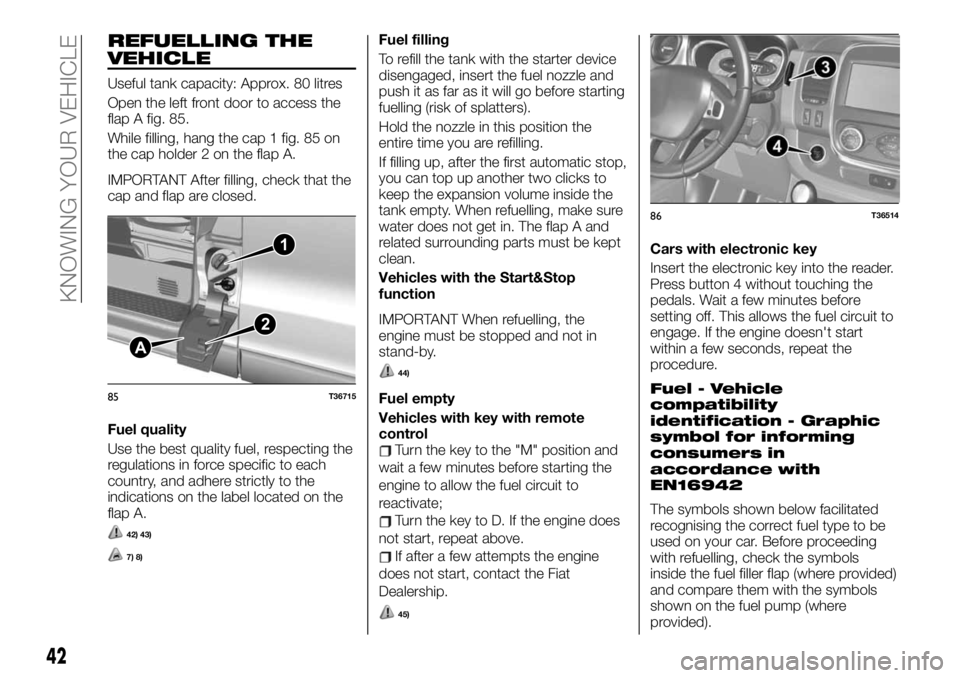
REFUELLING THE
VEHICLE
Useful tank capacity: Approx. 80 litres
Open the left front door to access the
flap A fig. 85.
While filling, hang the cap 1 fig. 85 on
the cap holder 2 on the flap A.
IMPORTANT After filling, check that the
cap and flap are closed.
Fuel quality
Use the best quality fuel, respecting the
regulations in force specific to each
country, and adhere strictly to the
indications on the label located on the
flap A.
42) 43)
7) 8)
Fuel filling
To refill the tank with the starter device
disengaged, insert the fuel nozzle and
push it as far as it will go before starting
fuelling (risk of splatters).
Hold the nozzle in this position the
entire time you are refilling.
If filling up, after the first automatic stop,
you can top up another two clicks to
keep the expansion volume inside the
tank empty. When refuelling, make sure
water does not get in. The flap A and
related surrounding parts must be kept
clean.
Vehicles with the Start&Stop
function
IMPORTANT When refuelling, the
engine must be stopped and not in
stand-by.
44)
Fuel empty
Vehicles with key with remote
control
Turn the key to the "M" position and
wait a few minutes before starting the
engine to allow the fuel circuit to
reactivate;
Turn the key to D. If the engine does
not start, repeat above.
If after a few attempts the engine
does not start, contact the Fiat
Dealership.
45)
Cars with electronic key
Insert the electronic key into the reader.
Press button 4 without touching the
pedals. Wait a few minutes before
setting off. This allows the fuel circuit to
engage. If the engine doesn't start
within a few seconds, repeat the
procedure.
Fuel - Vehicle
compatibility
identification - Graphic
symbol for informing
consumers in
accordance with
EN16942
The symbols shown below facilitated
recognising the correct fuel type to be
used on your car. Before proceeding
with refuelling, check the symbols
inside the fuel filler flap (where provided)
and compare them with the symbols
shown on the fuel pump (where
provided).
1
2
A
85T36715
86T36514
42
KNOWING YOUR VEHICLE
Page 45 of 236
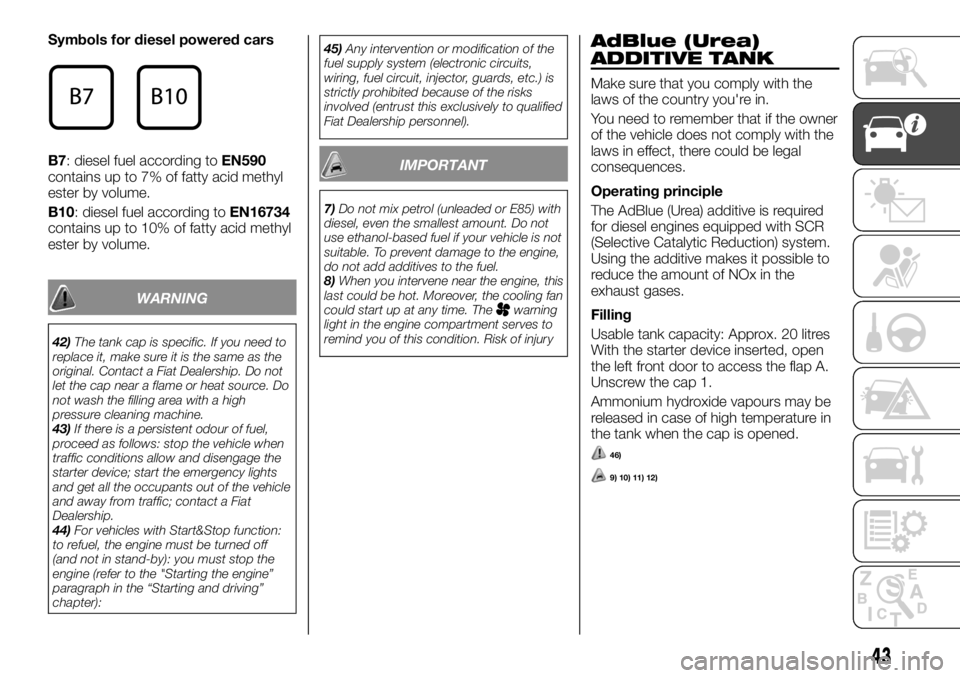
Symbols for diesel powered cars
B7: diesel fuel according toEN590
contains up to 7% of fatty acid methyl
ester by volume.
B10: diesel fuel according toEN16734
contains up to 10% of fatty acid methyl
ester by volume.
WARNING
42)The tank cap is specific. If you need to
replace it, make sure it is the same as the
original. Contact a Fiat Dealership. Do not
let the cap near a flame or heat source. Do
not wash the filling area with a high
pressure cleaning machine.
43)If there is a persistent odour of fuel,
proceed as follows: stop the vehicle when
traffic conditions allow and disengage the
starter device; start the emergency lights
and get all the occupants out of the vehicle
and away from traffic; contact a Fiat
Dealership.
44)For vehicles with Start&Stop function:
to refuel, the engine must be turned off
(and not in stand-by): you must stop the
engine (refer to the "Starting the engine”
paragraph in the “Starting and driving”
chapter):45)Any intervention or modification of the
fuel supply system (electronic circuits,
wiring, fuel circuit, injector, guards, etc.) is
strictly prohibited because of the risks
involved (entrust this exclusively to qualified
Fiat Dealership personnel).
IMPORTANT
7)Do not mix petrol (unleaded or E85) with
diesel, even the smallest amount. Do not
use ethanol-based fuel if your vehicle is not
suitable. To prevent damage to the engine,
do not add additives to the fuel.
8)When you intervene near the engine, this
last could be hot. Moreover, the cooling fan
could start up at any time. The
warning
light in the engine compartment serves to
remind you of this condition. Risk of injury
AdBlue (Urea)
ADDITIVE TANK
Make sure that you comply with the
laws of the country you're in.
You need to remember that if the owner
of the vehicle does not comply with the
laws in effect, there could be legal
consequences.
Operating principle
The AdBlue (Urea) additive is required
for diesel engines equipped with SCR
(Selective Catalytic Reduction) system.
Using the additive makes it possible to
reduce the amount of NOx in the
exhaust gases.
Filling
Usable tank capacity: Approx. 20 litres
With the starter device inserted, open
the left front door to access the flap A.
Unscrew the cap 1.
Ammonium hydroxide vapours may be
released in case of high temperature in
the tank when the cap is opened.
46)
9) 10) 11) 12)
43
Page 46 of 236
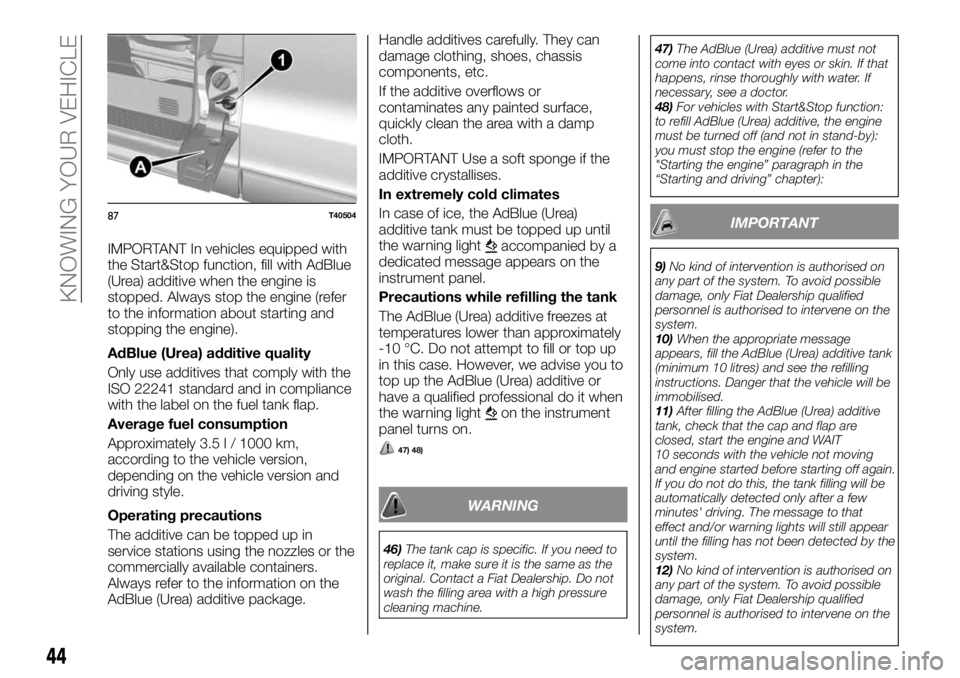
IMPORTANT In vehicles equipped with
the Start&Stop function, fill with AdBlue
(Urea) additive when the engine is
stopped. Always stop the engine (refer
to the information about starting and
stopping the engine).
AdBlue (Urea) additive quality
Only use additives that comply with the
ISO 22241 standard and in compliance
with the label on the fuel tank flap.
Average fuel consumption
Approximately 3.5 l / 1000 km,
according to the vehicle version,
depending on the vehicle version and
driving style.
Operating precautions
The additive can be topped up in
service stations using the nozzles or the
commercially available containers.
Always refer to the information on the
AdBlue (Urea) additive package.Handle additives carefully. They can
damage clothing, shoes, chassis
components, etc.
If the additive overflows or
contaminates any painted surface,
quickly clean the area with a damp
cloth.
IMPORTANT Use a soft sponge if the
additive crystallises.
In extremely cold climates
In case of ice, the AdBlue (Urea)
additive tank must be topped up until
the warning lightaccompanied by a
dedicated message appears on the
instrument panel.
Precautions while refilling the tank
The AdBlue (Urea) additive freezes at
temperatures lower than approximately
-10 °C. Do not attempt to fill or top up
in this case. However, we advise you to
top up the AdBlue (Urea) additive or
have a qualified professional do it when
the warning light
on the instrument
panel turns on.
47) 48)
WARNING
46)The tank cap is specific. If you need to
replace it, make sure it is the same as the
original. Contact a Fiat Dealership. Do not
wash the filling area with a high pressure
cleaning machine.47)The AdBlue (Urea) additive must not
come into contact with eyes or skin. If that
happens, rinse thoroughly with water. If
necessary, see a doctor.
48)For vehicles with Start&Stop function:
to refill AdBlue (Urea) additive, the engine
must be turned off (and not in stand-by):
you must stop the engine (refer to the
"Starting the engine” paragraph in the
“Starting and driving” chapter):
IMPORTANT
9)No kind of intervention is authorised on
any part of the system. To avoid possible
damage, only Fiat Dealership qualified
personnel is authorised to intervene on the
system.
10)When the appropriate message
appears, fill the AdBlue (Urea) additive tank
(minimum 10 litres) and see the refilling
instructions. Danger that the vehicle will be
immobilised.
11)After filling the AdBlue (Urea) additive
tank, check that the cap and flap are
closed, start the engine and WAIT
10 seconds with the vehicle not moving
and engine started before starting off again.
If you do not do this, the tank filling will be
automatically detected only after a few
minutes' driving. The message to that
effect and/or warning lights will still appear
until the filling has not been detected by the
system.
12)No kind of intervention is authorised on
any part of the system. To avoid possible
damage, only Fiat Dealership qualified
personnel is authorised to intervene on the
system.
87T40504
44
KNOWING YOUR VEHICLE
Page 47 of 236
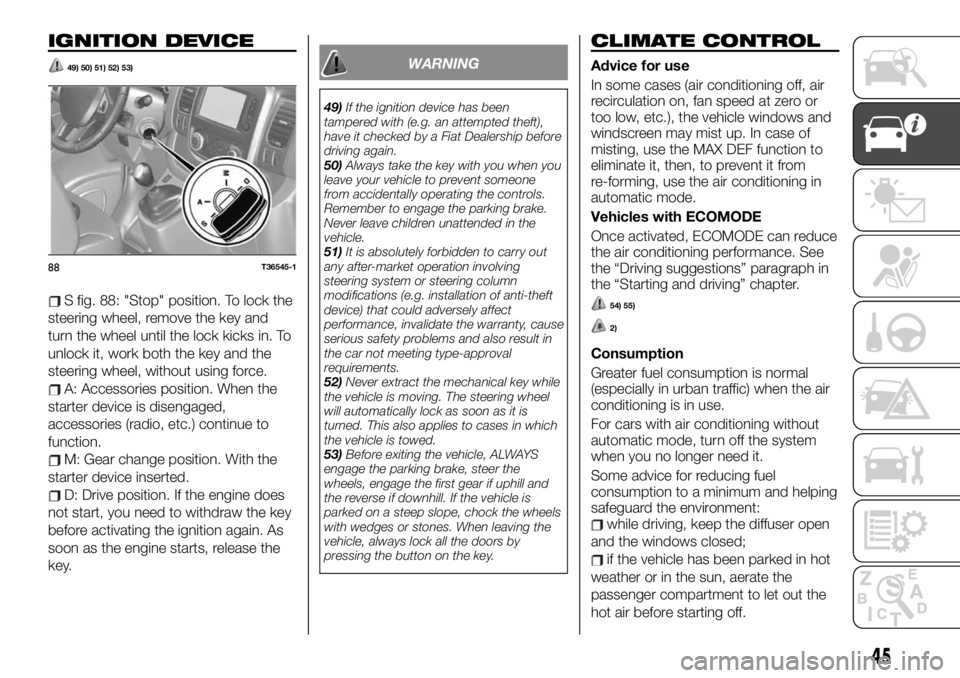
IGNITION DEVICE
49) 50) 51) 52) 53)
S fig. 88: "Stop" position. To lock the
steering wheel, remove the key and
turn the wheel until the lock kicks in. To
unlock it, work both the key and the
steering wheel, without using force.
A: Accessories position. When the
starter device is disengaged,
accessories (radio, etc.) continue to
function.
M: Gear change position. With the
starter device inserted.
D: Drive position. If the engine does
not start, you need to withdraw the key
before activating the ignition again. As
soon as the engine starts, release the
key.
WARNING
49)If the ignition device has been
tampered with (e.g. an attempted theft),
have it checked by a Fiat Dealership before
driving again.
50)Always take the key with you when you
leave your vehicle to prevent someone
from accidentally operating the controls.
Remember to engage the parking brake.
Never leave children unattended in the
vehicle.
51)It is absolutely forbidden to carry out
any after-market operation involving
steering system or steering column
modifications (e.g. installation of anti-theft
device) that could adversely affect
performance, invalidate the warranty, cause
serious safety problems and also result in
the car not meeting type-approval
requirements.
52)Never extract the mechanical key while
the vehicle is moving. The steering wheel
will automatically lock as soon as it is
turned. This also applies to cases in which
the vehicle is towed.
53)Before exiting the vehicle, ALWAYS
engage the parking brake, steer the
wheels, engage the first gear if uphill and
the reverse if downhill. If the vehicle is
parked on a steep slope, chock the wheels
with wedges or stones. When leaving the
vehicle, always lock all the doors by
pressing the button on the key.
CLIMATE CONTROL
Advice for use
In some cases (air conditioning off, air
recirculation on, fan speed at zero or
too low, etc.), the vehicle windows and
windscreen may mist up. In case of
misting, use the MAX DEF function to
eliminate it, then, to prevent it from
re-forming, use the air conditioning in
automatic mode.
Vehicles with ECOMODE
Once activated, ECOMODE can reduce
the air conditioning performance. See
the “Driving suggestions” paragraph in
the “Starting and driving” chapter.
54) 55)
2)
Consumption
Greater fuel consumption is normal
(especially in urban traffic) when the air
conditioning is in use.
For cars with air conditioning without
automatic mode, turn off the system
when you no longer need it.
Some advice for reducing fuel
consumption to a minimum and helping
safeguard the environment:
while driving, keep the diffuser open
and the windows closed;
if the vehicle has been parked in hot
weather or in the sun, aerate the
passenger compartment to let out the
hot air before starting off.
88T36545-1
45
Page 48 of 236
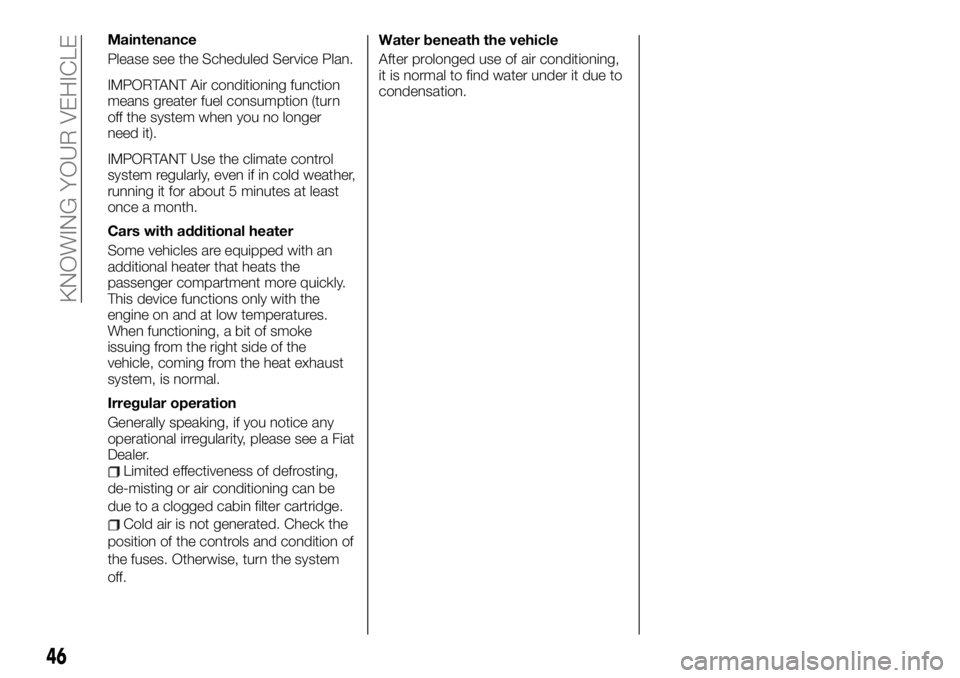
Maintenance
Please see the Scheduled Service Plan.
IMPORTANT Air conditioning function
means greater fuel consumption (turn
off the system when you no longer
need it).
IMPORTANT Use the climate control
system regularly, even if in cold weather,
running it for about 5 minutes at least
once a month.
Cars with additional heater
Some vehicles are equipped with an
additional heater that heats the
passenger compartment more quickly.
This device functions only with the
engine on and at low temperatures.
When functioning, a bit of smoke
issuing from the right side of the
vehicle, coming from the heat exhaust
system, is normal.
Irregular operation
Generally speaking, if you notice any
operational irregularity, please see a Fiat
Dealer.
Limited effectiveness of defrosting,
de-misting or air conditioning can be
due to a clogged cabin filter cartridge.
Cold air is not generated. Check the
position of the controls and condition of
the fuses. Otherwise, turn the system
off.Water beneath the vehicle
After prolonged use of air conditioning,
it is normal to find water under it due to
condensation.
46
KNOWING YOUR VEHICLE